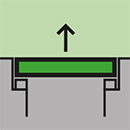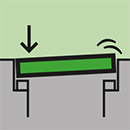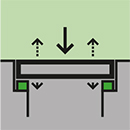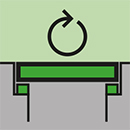Only manhole covers, frames, and bridge drains that meet the strict criteria of the RAL-GZ 692 quality mark are certified. These products must comply with the demanding standards of the Quality and Testing Specifications for Cast Iron Products for Sewers (Kanalguss) in terms of safety, durability, and sustainability. To earn the RAL quality mark, products must demonstrate characteristics and performance features that go beyond the requirements of DIN EN 124 and DIN 1229. These enhanced criteria must be verified through comprehensive test results, ensuring superior quality and long-term reliability.
In addition to strict product requirements, a quality management system in accordance with DIN EN ISO 9001 and an environmental management system in accordance with DIN EN 14001 are essential prerequisites for obtaining the RAL-GZ 692 quality mark. All criteria are continuously monitored by independent, accredited testing and certification bodies, ensuring consistent compliance and transparency throughout the entire certification process.
Passavant cast iron products are tested beyond DIN EN 124 and certified with the RAL-GZ 692 quality symbol:
Further information on the subject of GET and the RAL-GZ 692 can be found in the brochure.
For further information on the GET Gütegemeinschaft Entwässerungstechnik e. V. please visit:
www.get-guete.de.
A summary of the four most important testing procedures used to ensure operational and traffic safety for products certified with the RAL-GZ 692 quality mark, going beyond the requirements of DIN EN 124.
Why is it tested?
The pull-out force is a critical factor in determining the secure positioning of covers and gratings under dynamic traffic loads. A higher pull-out force means greater protection against the risk of the cover or grate being dislodged or rotated. For loosely inserted covers and gratings, national standards specify minimum mass per unit area (kg/m²). Lighter components must be secured using a locking mechanism or a special design that complies with the standard. However, these standards do not define specific performance requirements for such securing methods. This gap is addressed by the pull-out test, which requires a pull-out resistance 1.5 times higher than that of an unsecured cover or grate. The goal is to ensure that even when locking devices are worn or aged, the cover or grate remains securely in place.
How is the test performed?
Loosely inserted covers and gratings are first checked to ensure they meet the minimum mass per unit area defined by national standards. For lighter components, the test evaluates whether the locking mechanism or special design can withstand a mechanical pull-out force.
During and after the test:
- The locking device must remain intact and functional.
- Deformation or damage to the cover/grate or its fastening elements is only permitted within strictly defined limits.
- Protrusion of the cover or grate must not exceed the allowable threshold.
Why is tilting behavior tested?
When covers or gratings are loosely inserted, there's a risk they may tilt if a vehicle wheel rolls over the joint and strikes the edge. This impact can cause the opposite side to lift, compromising the stability of the component. The greater the tilt or lift, the more unstable the positioning becomes. This increases the likelihood of rattling noises and, in extreme cases, the cover or grate being ejected from its frame, posing serious safety risks for road users. As a result, tilting behavior is a critical factor in assessing the operational and traffic safety of manhole covers and frames. The extent of tilting largely depends on the design and construction of the cover or grate. Since DIN EN 124 does not include a test for this, the RAL-GZ 692 quality mark fills this important gap.
How is the tilting test conducted?
For rectangular or circular covers and gratings that are loosely inserted, the test measures how an increasing vertical force applied to the edge causes the opposite side to lift. Measurements are taken at multiple defined points. The permissible tilt values are extremely low and remain well below the risk threshold for the component being dislodged from its frame. For lighter covers or gratings equipped with traffic-safe locking mechanisms, the fastening must remain secure and intact throughout the test.
Why is the damping insert tested?
Damping inserts play a crucial role in enhancing positional stability and reducing noise emissions. Depending on their thickness, hardness, elasticity, and material, these inserts compress to varying degrees when subjected to traffic loads. If the difference between the unloaded and loaded states is too great, a “trampoline effect” may occur - where the cover or grate is momentarily lifted and potentially ejected from its frame. This poses serious risks to operational and traffic safety. Since DIN EN 124 does not include a test for damping behavior, no specific limit values are defined. The RAL-GZ 692 quality mark addresses this safety gap by introducing a dedicated test procedure.
How is the test conducted?
A vertical force is applied to the cover or grate to measure the deformation of the damping insert. To ensure safety and prevent the trampoline effect, the maximum allowable deformation must not exceed 3 mm.
Why is long-term testing required?
In real-world conditions, manhole covers and frames are exposed to a wide range of dynamic and sometimes extreme loads that cannot be fully replicated through isolated technical tests. That’s why the RAL-GZ 692 quality mark requires a critical long-term evaluation of all relevant quality and safety aspects under practical conditions.
How is the testing conducted?
Before market launch, all new products undergo an initial testing phase based on the manufacturer’s specifications. Once released to the market, a 12-month quality observation period begins, in accordance with the RAL-GZ 692 quality regulations.
During this period:
- All design and production-related defects are systematically recorded and assessed.
- If systemic issues are identified, they must be disclosed and corrected before the quality mark can be awarded.
- The entire process is monitored by an independent inspector.
The RAL-GZ 692 quality mark is only granted after successful completion of the one-year probationary period, ensuring that certified products meet the highest standards of safety, reliability, and durability.



